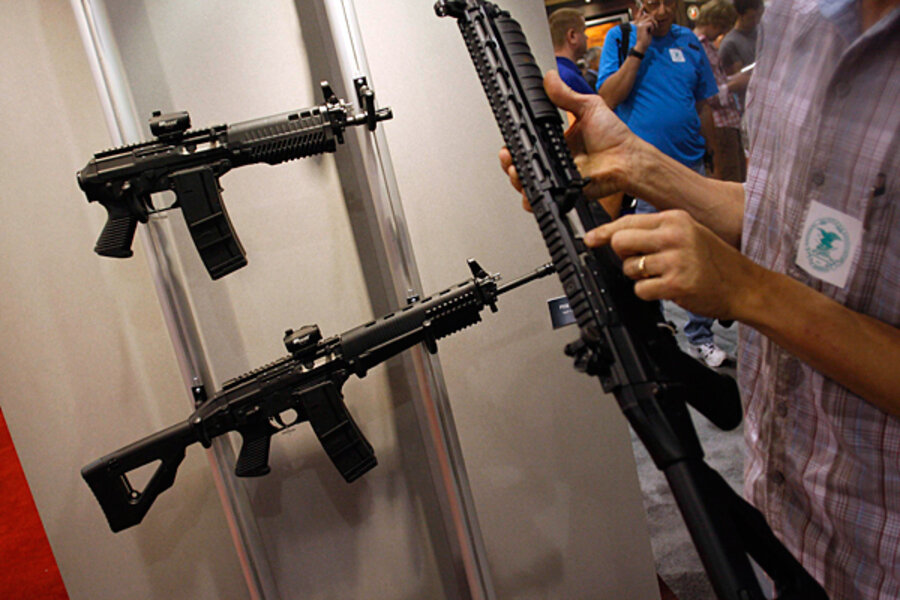How would a new US ban on assault rifles work?
Loading...
How would a ban on semi-automatic assault rifles work? That could well be a big issue in Congress next year in the wake of the tragic Newtown, Conn., school shooting.
A military-style assault rifle and multiple high-capacity ammunition magazines were among the weapons Adam Lanza carried when he stormed into Sandy Hook Elementary School last Friday. As a result, even some pro-gun lawmakers such as Sen. Joe Manchin (D) of West Virginia say it’s time to think about reinstituting a federal assault rifle prohibition.
“I don’t know anyone in the sporting or hunting arena that goes out with an assault rifle. I don’t know anybody that needs 30 rounds in a clip to go hunting. I mean, these are things that need to be talked about,” said Senator Manchin on Monday.
Sen. Dianne Feinstein (D) of California says she will introduce legislation banning assault weapons as a first order of business when the next Congress convenes. It will be based upon a similar bill that lawmakers passed in 1994, banning the rifles for 10 years.
“It will be carefully focused on the most dangerous guns that have killed so many people over the years while protecting the rights of gun owners by exempting hundreds of weapons that fall outside the bill’s scope,” said Senator Feinstein via a press release.
Assault rifles are high-powered small-caliber rifles styled to look as if they belong in the US Army’s arsenal. In military use they can function as fully automatic weapons, firing multiple bullets with one pull of the trigger. But US civilians have been prohibited from owning automatic machine guns since the 1930s. Assault rifles available for domestic sale are semi-automatic, meaning a pull of the trigger fires one bullet.
Semi-automatic firearms per se won’t be banned, because that would mean ending traffic in pretty much every rifle and handgun available for sale in the United States. Instead, Feinstein’s legislation names specific models of rifles it would prohibit. According to a version of the bill she introduced in 2005, these would include rifles known as AK-47s, AR-15s, and Uzis, among others.
In addition, the Feinstein bill probably would ban the ownership, transfer, or manufacture of any rifle that is capable of accepting a detachable magazine and has two or more of these five characteristics: a folding or telescoping stock, a pistol grip, a bayonet mount, a muzzle flash suppressor or threaded barrel capable of accepting such a suppressor, or a grenade launcher.
The legislation also would prohibit the sale or ownership of any ammo-feeding device such as a magazine or belt capable of holding more than 10 rounds.
This sounds comprehensive, but it is important to note that the legislation contains one very large loophole. As Feinstein notes in her press release, anyone who currently has a legally owned assault rifle would be able to keep it. It would be legal to continue to resell these weapons. So America’s assault rifle arsenal would not get much smaller. It would just not get any larger.
It's unclear if the law as Feinstein wrote it up in 2005 would have prevented Mr. Lanza's mother from obtaining the rifle and magazines used in the assault on Sandy Hook Elementary School. Under the terms of the bill, Nancy Lanza would not have been able to buy either of them new, but she would have been able legally to obtain them used on the open market.
According to new Congressional Research Service (CRS) primer on US gun-control laws, there are no good data on the current number of assault rifles in civilian hands. But a 1994 study estimated that Americans owned 1.5 million such weapons.
Proponents of banning assault rifles argue that they have no place in civilian gun stocks, particularly if outfitted with high-capacity magazines, notes the CRS study. Opponents of the ban say the guns are being singled out solely due to their appearance.
“Opponents ... argue that the statutorily defined characteristics of a semiautomatic assault weapon [are] largely cosmetic, and that these weapons [are] potentially no more lethal than other semiautomatic firearms,” writes CRS analyst William Krouse.
Mr. Krouse notes that there are no definitive data indicating whether the number of people shot and killed with assault weapons went down during the 10 years they were banned. Other experts, however, say there is some evidence that gun murders rose in Mexico after the assault weapons ban expired in 2004. According to a study by a group of New York University political scientists, areas of Mexico adjacent to states that allowed the resumption of assault weapons sales saw a “substantial” rise in the use of these weapons in killings, while areas next to California, which maintained a state-level ban, did not.








